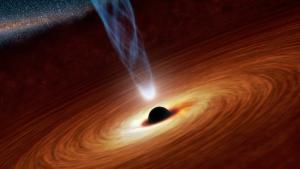Post
Not So Fast
10 August 2013
 NASA/JPL-Caltech
NASA/JPL-CaltechSupermassive black holes in the center of galaxies rotate at very high speeds. Typically the rotation speed of a galactic black hole is measured by looking at x-rays reflected off the accretion disk of the black hole.
If you imagine an accretion disk as a spinning frisbee, you can see that one side of the disk is spinning away from us, while another part is spinning toward us. When x-rays scatter off the material in the disk, the motion of the material affects the scattering so that the x-rays can gain or lose energy when they scatter. If it scatters off material moving toward us, it gains energy, and if it scatters off material moving away from us, it loses energy.
Astronomers typically observe a particularly bright emission line in the x-rays caused by iron atoms. If the accretion material were at rest, the emission line would have a fairly narrow wavelength range. But because of the motion of the disk, the scattering that gains energy has a blue-shifted emission line, while the scattering that loses energy has a red-shifted emission line. This means the motion of the accretion disk produces a broader emission line. The faster the rotation, the broader the line.
Since the accretion disk rotates at a rate similar to the black hole itself, by measuring the emission line astronomers can determine just how fast a galactic black hole rotates. What we’ve found is that many galactic black holes rotate at more than 90% of the maximum theoretical speed for a black hole.
Such a fast rotation would imply that these supermassive black holes were produced by galactic mergers. It would be very difficult for a black hole to reach a near-maximum rotation speed by forming within a galaxy, but collisions between galaxies can impart a large amount of rotation to the resulting merger. So many galactic black holes have high rotation, which would imply that most galactic black holes (and thus most galaxies) are a product of mergers.
Of course there has been a bit of controversy over this observation method. Since the line broadening is produced by scattered x-rays, it is possible that there are other mechanisms affecting the broadening. If the broadening is not caused solely by rotation, then our determination of rotation speed would be a bit off. It would be better to measure an emission line produced within the accretion disk itself. This would give us a direct measurement of the speed of the accretion disk.
Unfortunately such direct emission lines have been too faint to observe clearly. But recently in the Monthly Notices of the Royal Astronomical Society a new method of observing direct emission lines has been presented.1 The team used this method to measure the rotation of the black hole in the galaxy PG1244+026, about 500 million light years away.
Observations of the scattering line gave a rotation speed almost at maximum, but this new method gave a rotation which is at most 86% of the maximum. This would imply that the traditional scattering measurement over estimates the rotation speed. But this is only a single observation. While direct observation gives a lower rotation speed in for this black hole, that may not be the case for all black holes. It will take more observations to determine if this is an exceptional case, or if the traditional scattering measurement has an inherent bias.
Perhaps black holes are not so fast after all.
Done, Chris, et al. “A new way to measure supermassive black hole spin in accretion disc-dominated active galaxies.” Monthly Notices of the Royal Astronomical Society 434.3 (2013): 1955-1963. ↩︎